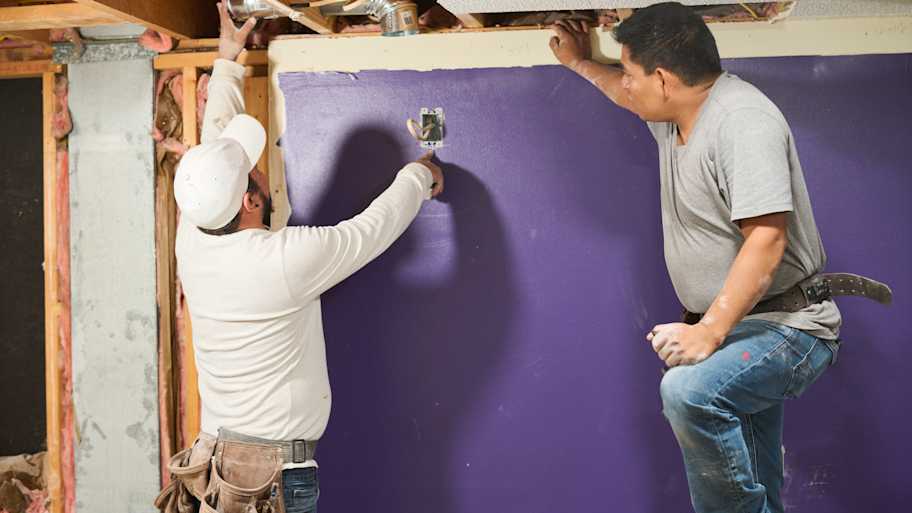7 Types of Drywall Anchors and What They’re Used For
Anchors away–give your artwork and shelves the support they need


When it’s time to hang artwork or shelves on your wall, you’ve got options. But taking your chance with a hammer and nail can lead to a smashed picture frame, or worse, a crushed toe. Your best bet is to use an anchor, but the type of drywall anchor you need depends on the size and weight of the object you're hanging. Take a look at these drywall anchor options and when you should use each one.
| Drywall Anchor Type | Weight Capacity | Weight Capacity in Pounds | Drywall Anchor Uses | Reusable |
|---|---|---|---|---|
| Toggle bolt | Heavy | 30–100+ | TVs, cabinets, pantry shelves, and bookshelves | Yes |
| Molly bolt | Medium to heavy | 25–75 | Light shelves, mirrors, and thicker picture frames | Yes |
| Threaded drywall anchors | Medium to heavy | 25–75 | Mirrors, shelves, and thicker picture frames | Yes, if metal |
| Strap-toggle anchors | Medium to heavy | 30–80 | TVs, shelves, medium-weight cabinets, and shelves | Yes |
| Plastic winged anchor | Medium | 5–75 | Towel rods, coat hooks, and thicker picture frames | No |
| Self-drilling anchor | Light | 5–20 | Picture frames, small mirror, and curtain rod | No |
| Plastic expansion anchor | Light | 5–20 | Small picture frames, and small mirrors | No |
1. Toggle Bolt

A toggle bolt is the strongest anchor. Whatever you want to mount on it, it can handle it.
This drywall anchor consists of two parts: a machine bolt and a metal toggle. The toggle is what acts as the anchor. It folds in the center, similar to a pair of butterfly wings. Once pushed through the drywall, it opens up and lays flat against the inner wall.
To use a toggle bolt, drill a hole in the wall, matching the size of the toggle. Then, thread the bolt through the object you're hanging and attach the toggle to the end. Flatten the toggle, then push it into the pre-drilled hole.
You'll hear a click when the toggle opens on the other side of the wall. You can then tighten the bolt the rest of the way, firmly attaching the object to the wall.
The weight a toggle bolt can hold varies by size. The bigger the toggle, the higher the weight limit. A 1/4-inch toggle bolt, for example, can support up to 90 pounds.
Toggle bolt uses: Mounting a heavy item, like a bookshelf, pantry shelf, or television
2. Molly Bolt

The molly bolt—sometimes called a hollow wall anchor—can also support heavy objects, but not as heavy as a toggle bolt. If you've got a hefty mirror or small shelf to put up, a molly bolt is the way to go.
A molly bolt looks like a screw encased in metal. When you screw the bolt into the drywall, the metal casing expands, providing support on the back side of the wall.
To use a molly bolt, you need to drill a pilot hole into the wall and then push the molly bolt through the hole. Tap on the bolt with a hammer to push it all the way in. Once the bolt is in the wall, remove the screw. As you twist the screw to remove it, the bolt will expand, securing itself to the wall.
Next, attach whatever you're hanging to the wall and use the screw to hold it in place.
If you’re unsure which drywall anchor is right for your project, you can hire a local handyperson to hang your pictures and shelves so they don’t fall off the wall.
Molly bolt uses: Heavy mirror, small shelving, coat hook, or hefty picture frames
3. Plastic Winged Anchor

A plastic winged anchor can be an alternative to a molly bolt. It’s designed for medium-duty use and can support a smaller shelf or heavier picture frame or mirror. The plastic winged anchor is similar to a toggle bolt, except it has plastic wings instead of a metal toggle. Since it’s made of plastic, it can't support as much weight as a metal toggle.
Like a molly and toggle bolt, you need to drill a hole in the wall before attaching a plastic winged anchor. You then slip the anchor into the wall, tap it to ensure it's fully in place, and remove the screw to expand the wings.
Plastic winged anchor uses: Light-duty shelf, towel rod, coat hook, mirror, or heavier picture frame
4. Self-Drilling Anchor

A self-drilling anchor looks like a screw within a screw. It can consist of a plastic outer screw and inner metal screw or a metal outer screw and inner metal screw.
The beauty of a self-drilling anchor is that you don't have to drill a pilot hole to use this drywall anchor. The threads on the anchor are sharp enough to cut through drywall, so no predrilling is required. Unfortunately, those sharp threads can cut into the drywall too much if you overtighten the anchor, causing it to crumble and limiting its effectiveness.
Whether a self-drilling anchor expands depends on the material. A plastic anchor does split open and expand, while a metal one does not. Thanks to its large threads, a metal self-drilling anchor provides support.
A self-drilling anchor is best used with lightweight objects, as it can't support much weight. The metal anchor can hold more weight than the plastic version.
Self-drilling anchor uses: Picture frame and smaller mirror, wall art, and curtain rod
5. Plastic Expansion Anchor

The plastic expansion anchor may be what comes to mind when you think about a drywall anchor. It consists of a plastic sheath and a screw. The plastic sheath comes in various lengths, and the screw length corresponds to it. For just a few dollars, you can often find plastic expansion anchors in a box containing several hundred at the hardware.
When inserted into a wall and screwed into place, the plastic sheath expands or splits, securing itself against the wall.
You need to drill a pilot hole to use a plastic expansion anchor. The hole should be slightly smaller than the width of the plastic sheath. Once you drill the hole, slip the sheath inside and tap it into place with a hammer. To mount a picture frame or other lightweight object, thread the screw into the anchor and tighten it.
Plastic expansion anchor uses: Lightweight objects, such as a small picture frame and artwork, small mirror, or objects weighing under 25 pounds
6. Threaded Drywall Anchors

Threaded drywall anchors, a type of self-drilling drywall anchor, are a beefed-up and stronger expansion anchor. They have an external screwhead and a sharp tip, allowing for installation with a screwdriver and without predrilling. These anchors are made of plastic or metal and some split and expand for a sturdier grip.
They can handle loads up to 75 pounds. You have to be careful when installing them as overtightening this type of anchor can damage the drywall and weaken the anchor's hold. However, threaded drywall anchors are easy to remove by backing them out of the wall and turning them counterclockwise.
Threaded drywall anchor uses: Shelves, pictures, and mirrors up to 75 pounds
7. Strap-Toggle Anchors

Strap-toggle anchors balance strength with design simplicity. These anchors have plastic ratchet straps and a steel toggle with a threaded cap. They require a small pilot hole through which you’ll insert the anchor.
After you insert the anchor, use the straps to slide the cap in place. Then, you can remove the straps and install screws into the threaded hole in the cap to secure items.
Strap-toggle anchors have different weight ratings, with some holding over 80 pounds. They’re often used to hang televisions and lighter cabinets. Removing a strap-toggle anchor is as easy as cutting off the cap, which lets the remainder of the anchor fall and stay inside the wall.
Strap-toggle anchor uses: Television mounts, shelves, and medium-weight cabinets
Frequently Asked Questions
You may not need to use a drywall anchor, depending on what you're hanging and where you're hanging it. If you can nail or screw into a wooden stud, the wood will provide enough support and stability in many cases. If you're hanging something very lightweight, you can use picture hanging strips to hold it in place.
When choosing a drywall anchor, consider the weight of the object you're hanging and how much weight the anchor will need to support. The heavier the weight, the stronger the anchor you'll need. You’ll find the weight capacity on the packaging when shopping for anchors.
Also, remember that you can use more than one anchor when hanging something on the wall. If you're using multiple anchors, divide the object weight by the number of anchors to determine how much each will need to support. If you need help deciding which drywall anchor to use, you can hire a handyperson to hang your objects.
Whether you can reuse a drywall anchor or not depends on the type. Plastic expansion anchors and plastic self-drilling anchors, which expand once screwed into the wall, are single-use only. You can't straighten and reuse them after removing them from the wall.
Metal toggle bolts can be reused, provided you can successfully remove the toggle from behind the wall. Once you remove the bolt, the toggle often falls down and can be difficult to retrieve without removing the drywall.





- The 5 Best Anchors for Brick and How to Use Them
- 8 Types of Concrete Anchors: Which Is Right for Your Project?
- 8 of the Most Common Drywall Problems and How to Solve Them
- Heighten Your Home's Luxury Level with These 10 Designer-Approved Tips
- How to Hang a Picture 5 Different Ways
- How to Repair Water-Damaged Drywall
- How to Patch a Hole in Drywall (From Small to Large)
- 11 Handy Tips and Tricks to Help With Your Next Home Project
- 11 Must-Know DIY Drywall Repair Tips
- How to Remove a Stripped Screw—Try These 6 Methods










